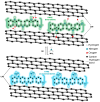Room-Temperature Ammonia Sensing Using Polyaniline-Coated Laser-Induced Graphene
- PMID: 39686369
- PMCID: PMC11644887
- DOI: 10.3390/s24237832
Room-Temperature Ammonia Sensing Using Polyaniline-Coated Laser-Induced Graphene
Abstract
The reliable detection of ammonia at room temperature is crucial for not only maintaining environmental safety but also for reducing the risks of hazardous pollutants. In this study, the electrochemical modification of laser-induced graphene (LIG) with polyaniline (PANI) led to the development of a chemo-resistive nanocomposite (PANI@LIG) for detecting ammonia levels at room temperature. The composite is characterized by field emission scanning electron microscopy, Fourier transforms infrared, and Raman and X-ray photoelectron spectroscopy. This work marks the first utilization of PANI@LIG for gas sensing and introduces a simple but effective approach for fabricating low-cost wearable gas sensors with high sensitivity and flexibility.
Keywords: ammonia; gas sensing; laser-induced graphene; polyaniline.
Conflict of interest statement
The authors declare no conflicts of interest.
Figures








Similar articles
-
Graphene/Nickel Oxide-Based Nanocomposite of Polyaniline with Special Reference to Ammonia Sensing.ACS Omega. 2018 Aug 17;3(8):9378-9387. doi: 10.1021/acsomega.8b00825. eCollection 2018 Aug 31. ACS Omega. 2018. PMID: 31459071 Free PMC article.
-
Enhanced room temperature ammonia gas sensing based on a multichannel PSS-functionalized graphene/PANI network.Analyst. 2025 Feb 10;150(4):669-679. doi: 10.1039/d4an01488j. Analyst. 2025. PMID: 39831568
-
The Room Temperature Highly Sensitive Ammonia Gas Sensor Based on Polyaniline and Nitrogen-Doped Graphene Quantum Dot-Coated Hollow Indium Oxide Nanofiber Composite.Polymers (Basel). 2021 Oct 25;13(21):3676. doi: 10.3390/polym13213676. Polymers (Basel). 2021. PMID: 34771232 Free PMC article.
-
Physical and Chemical Sensors on the Basis of Laser-Induced Graphene: Mechanisms, Applications, and Perspectives.ACS Nano. 2021 Dec 28;15(12):18708-18741. doi: 10.1021/acsnano.1c05806. Epub 2021 Dec 9. ACS Nano. 2021. PMID: 34881870 Review.
-
Recent Trends and Developments in Graphene/Conducting Polymer Nanocomposites Chemiresistive Sensors.Materials (Basel). 2020 Jul 24;13(15):3311. doi: 10.3390/ma13153311. Materials (Basel). 2020. PMID: 32722341 Free PMC article. Review.
Cited by
-
Conducting Polymers-Based Gas Sensors: Principles, Materials, and Applications.Sensors (Basel). 2025 Apr 25;25(9):2724. doi: 10.3390/s25092724. Sensors (Basel). 2025. PMID: 40363162 Free PMC article. Review.
-
Fabrication and Characterization of a Flexible Non-Enzymatic Electrochemical Glucose Sensor Using a Cu Nanoparticle/Laser-Induced Graphene Fiber/Porous Laser-Induced Graphene Network Electrode.Sensors (Basel). 2025 Apr 7;25(7):2341. doi: 10.3390/s25072341. Sensors (Basel). 2025. PMID: 40218852 Free PMC article.
References
-
- Mbayachi V.B., Ndayiragije E., Sammani T., Taj S., Mbuta E.R., Khan A.U. Graphene Synthesis, Characterization and Its Applications: A Review. Results Chem. 2021;3:100163. doi: 10.1016/j.rechem.2021.100163. - DOI
Grants and funding
- 2023 FI-2 00180/AGAUR-Personal Investigador Predoctoral en Formació (FI) ajuts Predoctoral Program
- 823895-PE/H2020-MSCA-RISE-2018: Marie Sklodowska-Curie Actions
- PDC2022- 133967-I00/Ministerio de Ciencia, Innovación y Universidades (MICINN)
- TED2021-131442B-C31/Ministerio de Ciencia, Innovación y Universidades (MICINN)
LinkOut - more resources
Full Text Sources

